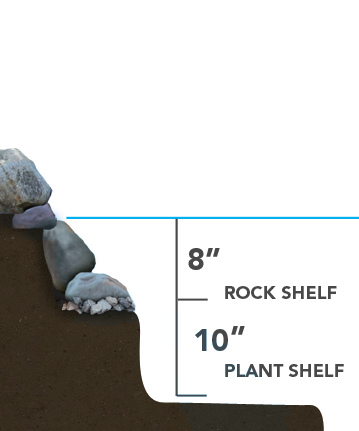Ponds 102 Chapter 5
The Inner Profile

One of the most important details often overlooked by beginners is exactly how they’ll be shaping the inside of the pond in advance.The profile of the walls and the shelves and the bottom of the pond can mean the difference between a safe pond or one that can trap whatever (or whomever) falls in; one that discourages wading predators like raccoons and herons or invites them in for a sushi banquet; an algae-ridden, mosquito infested hole or a clear, cool haven for its inhabitants. Proper shelf placement will hide and protect the liner forever while providing safe access in and out and just the right environment for both plants and fish, and keep maintenance to a minimum besides, by collecting debris where it can be most easily removed. There are many ways to shape the inside of the pond, but all successful designs share a couple of common features.
- The bottom needs to be as flat as possible, a series of level shelves rather than slopes, because there’s no way to walk on underwater slopes safely once things get good and slimy, as they will regardless what’s covering the liner. That “gentle” slope covered with gravel that’s so easy to walk on when dry will become a real hazard when you need to get in (or out) of the pond.
- The walls should be as vertical as possible, and in general shouldn’t exceed 2’ in height anywhere, especially along the edge. If you need to go deeper, make steps down to your final depth. Having straight sides and flat shelves makes for safe access in and out of the pond, and limiting the height of the walls makes them easy to hide and less likely to slump or collapse
- Design the pond with the convenient collection of debris in mind. Try to envision how the water flow from the waterfall will push leaves across the surface, and set your skimmer accordingly. Below the surface, set up the bottom to trap most of the debris in one or two deep spots that are accessible for cleaning.
- Plan for plants from the beginning! Set up shelves at the right depth for pots or excavate to create gravel pockets for direct plantings. Make your stream wide and deep enough in areas to accommodate marginal plantings that will not only help clean and clear the water, but beautify as well. Set up broad, shallow shelves along the edges to create perimeter bogs wherever you will have extra liner, like in the corners. Decide whether they will be active, with water running through them, or passive, where water merely seeps into the shallow gravel beds. A bog planting at the head of the stream can filter the entire pond if sized correctly. For sizing suggestions and more ideas, take a look in the College of Filtration.

One of the most important details often overlooked by beginners is exactly how they’ll be shaping the inside of the pond in advance.The profile of the walls and the shelves and the bottom of the pond can mean the difference between a safe pond or one that can trap whatever (or whomever) falls in; one that discourages wading predators like raccoons and herons or invites them in for a sushi banquet; an algae-ridden, mosquito infested hole or a clear, cool haven for its inhabitants. Proper shelf placement will hide and protect the liner forever while providing safe access in and out and just the right environment for both plants and fish, and keep maintenance to a minimum besides, by collecting debris where it can be most easily removed. There are many ways to shape the inside of the pond, but all successful designs share a couple of common features.
- The bottom needs to be as flat as possible, a series of level shelves rather than slopes, because there’s no way to walk on underwater slopes safely once things get good and slimy, as they will regardless what’s covering the liner. That “gentle” slope covered with gravel that’s so easy to walk on when dry will become a real hazard when you need to get in (or out) of the pond.
- The walls should be as vertical as possible, and in general shouldn’t exceed 2’ in height anywhere, especially along the edge. If you need to go deeper, make steps down to your final depth. Having straight sides and flat shelves makes for safe access in and out of the pond, and limiting the height of the walls makes them easy to hide and less likely to slump or collapse
- Design the pond with the convenient collection of debris in mind. Try to envision how the water flow from the waterfall will push leaves across the surface, and set your skimmer accordingly. Below the surface, set up the bottom to trap most of the debris in one or two deep spots that are accessible for cleaning.
- Plan for plants from the beginning! Set up shelves at the right depth for pots or excavate to create gravel pockets for direct plantings. Make your stream wide and deep enough in areas to accommodate marginal plantings that will not only help clean and clear the water, but beautify as well. Set up broad, shallow shelves along the edges to create perimeter bogs wherever you will have extra liner, like in the corners. Decide whether they will be active, with water running through them, or passive, where water merely seeps into the shallow gravel beds. A bog planting at the head of the stream can filter the entire pond if sized correctly. For sizing suggestions and more ideas, take a look in the College of Filtration.




